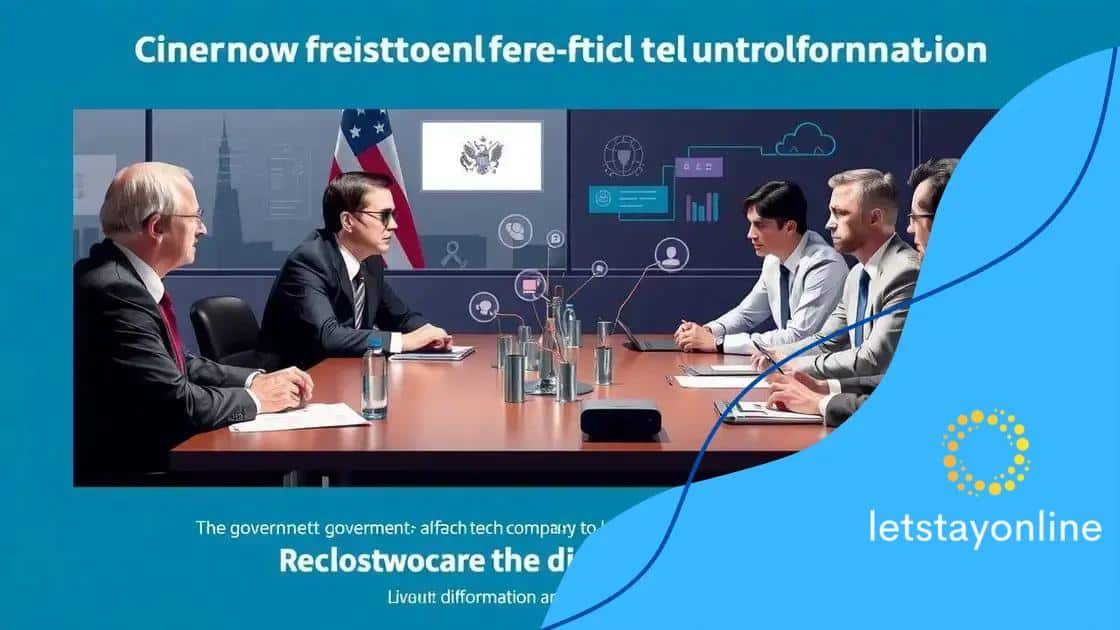New government frameworks to fight disinformation

New government frameworks to fight disinformation involve regulations, public education, and collaboration with tech companies to enhance accountability, improve media literacy, and effectively combat misleading information.
New government frameworks to fight disinformation are becoming crucial in our digital age. Have you ever wondered how these measures can affect public trust and information accuracy? Let’s dive into this important topic.
Understanding disinformation and its impacts
Understanding disinformation and its impacts is vital for today’s society. In our digital world, misinformation can spread rapidly, leading to confusion and mistrust. Recognizing the effects of disinformation is the first step in combating it effectively.
What is Disinformation?
Disinformation refers to false information that is deliberately created to deceive. Unlike misinformation, which may be unintentional, disinformation is used to manipulate opinions and behaviors. It can be spread through social media, websites, and traditional news sources.
Impacts of Disinformation
Disinformation can have serious consequences for individuals and communities. It can sway public opinion, create division, and undermine trust in important institutions. Here are some of the key impacts:
- Damaging trust in media sources
- Influencing political outcomes
- Causing public confusion and fear
- Undermining social cohesion
The effects of disinformation are not just theoretical. There are real-world examples where false narratives led to public unrest and safety concerns. By understanding how disinformation operates, we can better equip ourselves to challenge it.
Moreover, as technology advances, the sophistication of disinformation strategies continues to evolve. Artificial intelligence can generate convincing fake content, making it harder to discern truth from fabrication. Educating ourselves and others is crucial in countering these deceptive tactics.
Awareness and critical thinking are our best tools against disinformation. Engaging in discussions and sharing reliable information helps build a more informed community. It’s essential to question sources and verify facts before spreading information.
The role of government in combating disinformation
The role of government in combating disinformation is crucial in today’s information landscape. Governments worldwide are taking steps to address the challenges posed by misleading information. They recognize that fostering a well-informed public is essential for a healthy democracy.
Establishing Regulations
One of the key actions taken by governments is establishing regulations that promote transparency in information sharing. Such regulations require social media platforms to disclose how they manage content and penalize the spread of false information. This is aimed at holding entities accountable for the information they circulate.
- Defining clear guidelines for information sharing
- Imposing penalties on platforms for misuse
- Encouraging transparency in advertising
- Promoting media literacy programs
Aside from regulations, governments are also investing in technology to fight disinformation. Advanced tools using artificial intelligence can detect and flag misleading content before it goes viral. Awareness campaigns are another way the government plays a significant role. They inform the public about recognizing reliable sources and identifying disinformation.
Collaboration with Tech Companies
Collaboration is vital in this fight. Governments are working alongside technology companies to create solutions that effectively counter disinformation. These partnerships focus on educational initiatives and improving the algorithms that identify false narratives. By working together, they aim to create a safer online environment.
The involvement of independent fact-checking organizations is also critical. Governments often partner with these organizations to verify claims made in the media and on social platforms. This relationship helps to ensure a balanced approach to managing information. For citizens, knowing that there are reliable sources available can restore trust in media.
Moreover, governments have begun to hold public forums where citizens can express their concerns about disinformation. These discussions are essential in shaping policies that directly impact the community. Understanding public perception can help in developing more effective strategies.
Key frameworks introduced recently

Key frameworks introduced recently are vital in the fight against disinformation. Governments are developing comprehensive strategies to address the challenges posed by false information. These frameworks focus on collaboration, regulation, and public education.
New Regulatory Measures
Regulatory measures have been put in place to enhance accountability among media platforms. These measures include guidelines that require platforms to report the spread of disinformation promptly. By holding these platforms accountable, governments aim to reduce the impact of misleading information.
- Mandatory reporting of false information incidents
- Stricter penalties for non-compliance
- Transparency in data usage policies
- Support for independent fact-checking organizations
In addition to regulations, there is a strong emphasis on public education. Programs aimed at improving media literacy are being implemented. These initiatives help citizens discern reliable information sources from misleading ones. By educating the public, governments hope to create a more informed society.
Partnerships for Success
Many governments are forming partnerships with tech companies to create better tools for monitoring online content. These partnerships focus on using artificial intelligence to detect patterns in disinformation. Such technology can identify and flag misleading content quickly, preventing it from spreading.
Moreover, international cooperation is becoming essential. Countries are sharing knowledge and best practices to combat disinformation globally. Collaboration allows nations to strengthen their individual frameworks, making them more effective. This united front is crucial for addressing the evolving landscape of online misinformation.
Frameworks developed in response to recent events show a proactive approach. Policies are adapting to new challenges, ensuring that governments can keep pace with rapid technological changes. As these key frameworks take shape, the goal remains clear: to create a resilient society that knows how to handle disinformation.
Case studies of successful initiatives
Case studies of successful initiatives illustrate effective strategies in combating disinformation. Analyzing these cases helps us understand what works and inspires future efforts. Various countries have adopted innovative approaches that yield positive results.
Fact-Checking Initiatives
One prominent example is the rise of fact-checking organizations. Many countries support independent fact-checking groups that verify claims made by public figures and media. These organizations help educate the public on recognizing disinformation by providing easy access to verified information.
- Collaboration with social media platforms to flag false information
- Public awareness campaigns about the importance of fact-checking
- Partnerships with educational institutions to enhance media literacy
Another successful case is seen in countries that rely on strong media literacy programs. These initiatives teach citizens how to critically evaluate sources and spot disinformation. By building these skills, individuals become less susceptible to misleading narratives.
Government Partnerships
Sometimes, governments partner with tech companies to create tools that identify disinformation. For instance, an initiative in Europe combined AI technology with human oversight to track the spread of false news articles. This method allowed for rapid responses to newly emerging falsehoods.
Similarly, campaigns promoting transparency about the sources of information have proven effective. Initiatives encouraging platforms to disclose their algorithms can reduce the spread of misleading content. By understanding how information is shared, the public becomes more empowered to navigate the digital landscape.
Successful initiatives highlight the importance of collaboration among various stakeholders. Governments, educational institutions, and media organizations can work together to create a robust information ecosystem. Such teamwork not only combats disinformation but also fosters a culture of accountability and trust.
Future challenges in managing disinformation
Future challenges in managing disinformation are becoming increasingly complex as technology evolves. One of the biggest hurdles is the rise of artificial intelligence, which can produce highly convincing fake content. As this technology improves, it becomes harder for individuals and organizations to distinguish between real and fabricated information.
The Role of Social Media
Social media platforms present a significant challenge in this landscape. These platforms can amplify disinformation rapidly, allowing false narratives to reach millions in a short time. Despite ongoing efforts to combat misleading content, the sheer volume of information makes it difficult to monitor effectively.
- Algorithms may prioritize engagement over accuracy
- Users’ cognitive biases can influence what they share
- Difficulty in enforcing regulations across different countries
- Emergence of echo chambers that reinforce misinformation
Moreover, the spread of disinformation often intersects with political agendas, complicating efforts to manage it. Some actors intentionally use misleading information to sway public opinion, especially during elections and crises. As a result, combating disinformation requires not only technological solutions but also public awareness and education.
Educating the Public
Improving media literacy is vital to address the future challenges of disinformation. People need to learn how to verify information and recognize credible sources. Educational campaigns in schools and communities can empower individuals to critically evaluate the information they encounter online.
Additionally, collaboration between governments, tech companies, and academic institutions is essential for developing effective strategies. Such partnerships can focus on creating guidelines and tools that promote transparency and accountability. By working together, these groups can help build a resilient information environment.
Another challenge is adapting to new trends in communication. As platforms and technologies change, so do the styles and tactics of disinformation. Keeping up with these shifts is crucial for those working to combat misinformation.
FAQ – Frequently Asked Questions about New Government Frameworks to Fight Disinformation
What are government frameworks for combating disinformation?
Government frameworks consist of policies and strategies designed to reduce the spread of false information, promote transparency, and enhance public awareness.
How can individuals combat disinformation?
Individuals can combat disinformation by improving their media literacy, verifying sources before sharing information, and engaging in fact-checking.
What role do social media companies play in managing disinformation?
Social media companies are responsible for monitoring and flagging false information, implementing policies to reduce its spread, and promoting reliable content.
Why is media literacy important in today’s society?
Media literacy helps individuals critically analyze information, discern reliable sources, and protect themselves from being misled by false narratives.






